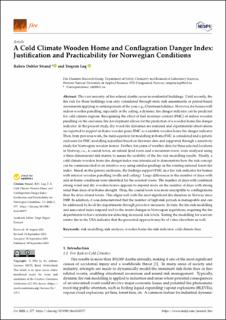| dc.description.abstract | The vast majority of fire-related deaths occur in residential buildings. Until recently, the fire risk for these buildings was only considered through static risk assessments or period-based assessments applying to certain periods of the year, e.g., Christmas holidays. However, for homes with indoor wooden panelling, especially in the ceiling, a dynamic fire danger indicator can be predicted for cold climate regions. Recognising the effect of fuel moisture content (FMC) of indoor wooden panelling on the enclosure fire development allows for the prediction of a wooden home fire danger indicator. In the present study, dry wood fire dynamics are analysed and experimental observations are reported to support in-home wooden panel FMC as a suitable wooden home fire danger indicator. Then, from previous work, the main equation for modelling in-home FMC is considered and a generic enclosure for FMC modelling is justified based on literature data and supported through a sensitivity study for Norwegian wooden homes. Further, ten years of weather data for three selected locations in Norway, i.e., a coastal town, an inland fjord town and a mountain town, were analysed using a three-dimensional risk matrix to assess the usability of the fire risk modelling results. Finally, a cold climate wooden home fire danger index was introduced to demonstrate how the risk concept can be communicated in an intuitive way using similar gradings as the existing national forest fire index. Based on the generic enclosure, the findings support FMC as a fire risk indicator for homes with interior wooden panelling (walls and ceiling). Large differences in the number of days with arid in-home conditions were identified for the selected towns. The number of days with combined strong wind and dry wooden homes appears to depend more on the number of days with strong wind than days of in-home drought. Thus, the coastal town was more susceptible to conflagrations than the drier inland towns. This aligns well with the most significant fire disasters in Norway since 1900. In addition, it was demonstrated that the number of high-risk periods is manageable and can be addressed by local fire departments through proactive measures. In turn, the fire risk modelling and associated index respond well to the recent changes in Norwegian regulations, requiring the fire departments to have systems for detecting increased risk levels. Testing the modelling for a severe winter fire in the USA indicates that the presented approach may be of value elsewhere as well. | en_US |

